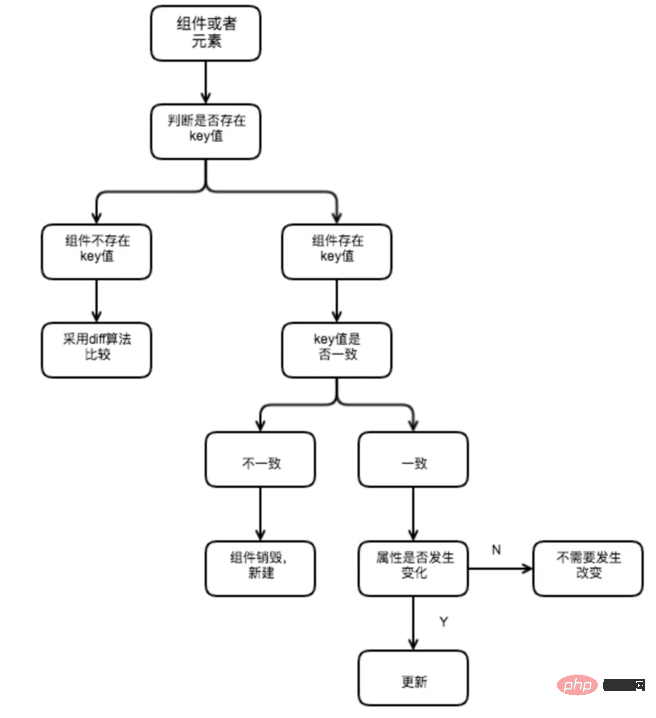What is the use of react's key?
The function of key in react is to determine whether the element is newly created or moved in the diff algorithm, thereby reducing unnecessary diffs, that is, to improve the efficiency of diff peer comparison and avoid in-place A side effect of reuse; key is an identifier used by react to track whether elements of the list have been modified, added or deleted.

The operating environment of this tutorial: Windows 10 system, react17.0.1 version, Dell G3 computer.
What is the use of react's key
Function
Like Vue, React also has a diff algorithm, and the role of the element key attribute is to Determine whether the element is newly created or moved, thereby reducing unnecessary Diff
In react's diff algorithm, react will use the key of the element to determine whether the element is newly created or moved. , thereby reducing unnecessary element rendering. In addition, react also needs to determine the relationship between the element and the local state based on the key
To put it simply, it is to improve the efficiency of peer comparison of diff and avoid the side effects caused by in-situ reuse.
Vue and react themselves both use the diff algorithm. Vue uses a more fine-grained update component method, which is to bind monitors to each attribute.
react uses the automatic With the top-down update strategy, every small change will generate a new vdom for diff. If the key is not written, it will happen that it should be updated but not
What is the key?
key is an auxiliary indicator used by react to track which list elements have been modified, added or deleted. During the development process, we need to ensure that the key of an element is unique among its sibling elements.
If the list data is being rendered and a piece of data is inserted after the data, the key will not play a big role, as follows:
this.state = {
numbers:[111,222,333]
}
insertMovie() {
const newMovies = [...this.state.numbers, 444];
this.setState({
movies: newMovies
})
}
<ul>
{
this.state.movies.map((item, index) => {
return <li>{item}</li>
})
}
</ul>The previous elements are exactly the same in the diff algorithm. , will not generate a delete or create operation. During the last comparison, it needs to be inserted into a new DOM tree.
Therefore, in this case, it does not mean much whether the element has a key attribute
Let’s take a look at the difference between using key and not using key when inserting data earlier:
insertMovie() {
const newMovies = [000 ,...this.state.numbers];
this.setState({
movies: newMovies
})
}When you have a key, react matches the sub-elements in the original tree and the latest ones based on the key attribute. For child elements in the tree, like the above situation, you only need to insert the 000 element into the front position
When there is no key, all li tags need to be modified
Similarly, it is not owned The key value represents higher performance. If only the text content has changed, the performance and efficiency will be higher if the key is not written.
The main reason is that if the key is not written, all the text content is replaced, and the nodes will not change.
Writing keys involves adding and deleting nodes. If it is found that the old key does not exist, it will be deleted. If the new key does not exist before, it will be inserted, which increases the performance overhead
Summary
Good use of key attributes is a very critical step in performance optimization. Notes are:
key should be the only one
key should not Use a random value (the random number will regenerate a number the next time it is rendered)
Avoid using index as the key
The process of react judging the key is as follows:

Recommended learning: "react video tutorial"
The above is the detailed content of What is the use of react's key?. For more information, please follow other related articles on the PHP Chinese website!

Hot AI Tools

Undresser.AI Undress
AI-powered app for creating realistic nude photos

AI Clothes Remover
Online AI tool for removing clothes from photos.

Undress AI Tool
Undress images for free

Clothoff.io
AI clothes remover

Video Face Swap
Swap faces in any video effortlessly with our completely free AI face swap tool!

Hot Article

Hot Tools

Notepad++7.3.1
Easy-to-use and free code editor

SublimeText3 Chinese version
Chinese version, very easy to use

Zend Studio 13.0.1
Powerful PHP integrated development environment

Dreamweaver CS6
Visual web development tools

SublimeText3 Mac version
God-level code editing software (SublimeText3)

Hot Topics
 Guide to React front-end and back-end separation: How to achieve decoupling and independent deployment of front-end and back-end
Sep 28, 2023 am 10:48 AM
Guide to React front-end and back-end separation: How to achieve decoupling and independent deployment of front-end and back-end
Sep 28, 2023 am 10:48 AM
React front-end and back-end separation guide: How to achieve front-end and back-end decoupling and independent deployment, specific code examples are required In today's web development environment, front-end and back-end separation has become a trend. By separating front-end and back-end code, development work can be made more flexible, efficient, and facilitate team collaboration. This article will introduce how to use React to achieve front-end and back-end separation, thereby achieving the goals of decoupling and independent deployment. First, we need to understand what front-end and back-end separation is. In the traditional web development model, the front-end and back-end are coupled
 How to build a reliable messaging app with React and RabbitMQ
Sep 28, 2023 pm 08:24 PM
How to build a reliable messaging app with React and RabbitMQ
Sep 28, 2023 pm 08:24 PM
How to build a reliable messaging application with React and RabbitMQ Introduction: Modern applications need to support reliable messaging to achieve features such as real-time updates and data synchronization. React is a popular JavaScript library for building user interfaces, while RabbitMQ is a reliable messaging middleware. This article will introduce how to combine React and RabbitMQ to build a reliable messaging application, and provide specific code examples. RabbitMQ overview:
 React Router User Guide: How to implement front-end routing control
Sep 29, 2023 pm 05:45 PM
React Router User Guide: How to implement front-end routing control
Sep 29, 2023 pm 05:45 PM
ReactRouter User Guide: How to Implement Front-End Routing Control With the popularity of single-page applications, front-end routing has become an important part that cannot be ignored. As the most popular routing library in the React ecosystem, ReactRouter provides rich functions and easy-to-use APIs, making the implementation of front-end routing very simple and flexible. This article will introduce how to use ReactRouter and provide some specific code examples. To install ReactRouter first, we need
 PHP, Vue and React: How to choose the most suitable front-end framework?
Mar 15, 2024 pm 05:48 PM
PHP, Vue and React: How to choose the most suitable front-end framework?
Mar 15, 2024 pm 05:48 PM
PHP, Vue and React: How to choose the most suitable front-end framework? With the continuous development of Internet technology, front-end frameworks play a vital role in Web development. PHP, Vue and React are three representative front-end frameworks, each with its own unique characteristics and advantages. When choosing which front-end framework to use, developers need to make an informed decision based on project needs, team skills, and personal preferences. This article will compare the characteristics and uses of the three front-end frameworks PHP, Vue and React.
 Integration of Java framework and front-end React framework
Jun 01, 2024 pm 03:16 PM
Integration of Java framework and front-end React framework
Jun 01, 2024 pm 03:16 PM
Integration of Java framework and React framework: Steps: Set up the back-end Java framework. Create project structure. Configure build tools. Create React applications. Write REST API endpoints. Configure the communication mechanism. Practical case (SpringBoot+React): Java code: Define RESTfulAPI controller. React code: Get and display the data returned by the API.
 How to use React to develop a responsive backend management system
Sep 28, 2023 pm 04:55 PM
How to use React to develop a responsive backend management system
Sep 28, 2023 pm 04:55 PM
How to use React to develop a responsive backend management system. With the rapid development of the Internet, more and more companies and organizations need an efficient, flexible, and easy-to-manage backend management system to handle daily operations. As one of the most popular JavaScript libraries currently, React provides a concise, efficient and maintainable way to build user interfaces. This article will introduce how to use React to develop a responsive backend management system and give specific code examples. Create a React project first
 Vue.js vs. React: Project-Specific Considerations
Apr 09, 2025 am 12:01 AM
Vue.js vs. React: Project-Specific Considerations
Apr 09, 2025 am 12:01 AM
Vue.js is suitable for small and medium-sized projects and fast iterations, while React is suitable for large and complex applications. 1) Vue.js is easy to use and is suitable for situations where the team is insufficient or the project scale is small. 2) React has a richer ecosystem and is suitable for projects with high performance and complex functional needs.
 What closures does react have?
Oct 27, 2023 pm 03:11 PM
What closures does react have?
Oct 27, 2023 pm 03:11 PM
React has closures such as event handling functions, useEffect and useCallback, higher-order components, etc. Detailed introduction: 1. Event handling function closure: In React, when we define an event handling function in a component, the function will form a closure and can access the status and properties within the component scope. In this way, the state and properties of the component can be used in the event processing function to implement interactive logic; 2. Closures in useEffect and useCallback, etc.






